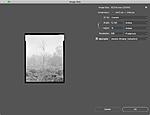
Originally Posted by
Steven Ruttenberg

(my scan files can pretty much stand o their own with no sharpening)
Yes.. nothing like having "native sharpness" !!!
Perhaps we should look a bit in the rear-view mirror.
I like the sharpening algorithms used by Sally Mann for her impressive prints. You place a 8x10 collodion plate in the enlarger's carrier... then we execute the algorithm:
/////////////////////////////////////////////
//GNU General Public License
/////////////////////////////////////////////
#include <iostream>
#include "enlarger.h"
int main()
{
Load_Default_Gear();
if(!sharp_negative() ) return GO_TO_SHOT;
for (int i = 0; i < MAX_FOCUS_OPS; i++) {
CImage* pImg = pEnlarger->Focus_Procedure(the_negative, loupe); // pointer pImg owned by CEnlarger instance
if (Check_Sharpness(pImg)) {
Print_Nice_Image(pImg);
return YOU_HAVE_A_NICE_PRINT;
}
}
return GO_ALIGN_ENLARGER;






 Reply With Quote
Reply With Quote


Bookmarks